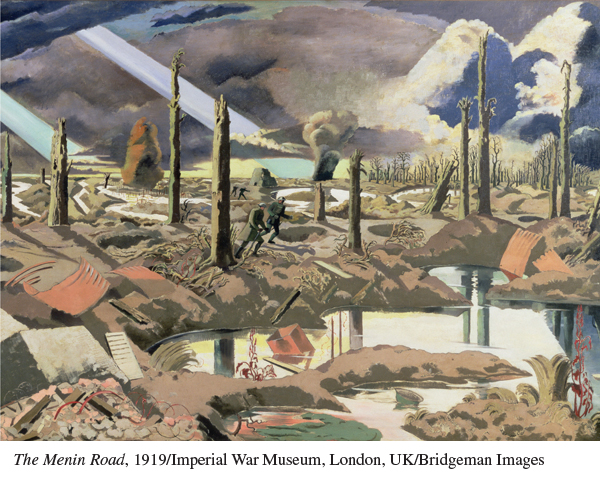A History of Western Society: Printed Page 826
A History of Western Society, Value Edition: Printed Page 795
A History of Western Society, Concise Edition: Printed Page 827
Introduction for Chapter 25
25
War and Revolution
1914–1919
In the summer of 1914 the nations of Europe went willingly to war. They believed they had no other choice. Both peoples and governments confidently expected a short war leading to a decisive victory and thought that European society would be able to go on as before. These expectations were totally mistaken. The First World War was long, indecisive, and tremendously destructive. To the shell-
From today’s perspective, it is clear that the First World War was closely connected to the ideals and developments of the previous century. Industrialization, which promised a rising standard of living, now produced horrendous weapons that killed and maimed millions. Imperialism, which promised to civilize those the Europeans considered savages, now led to intractable international conflicts. Nationalism, which promised to bring compatriots together in a harmonious nation-
The war would have an enormous impact on the century that followed. The need to provide extensive supplies and countless soldiers for the war effort created mass suffering, encouraged the rise of the bureaucratic state, and brought women in increasing numbers into the workplace. Millions were killed or wounded at the front, and millions more grieved these losses. Grand states collapsed: the Russian, Austro-

CHAPTER PREVIEW
What caused the outbreak of the First World War?
How did the First World War differ from previous wars?
In what ways did the war transform life on the home front?
Why did world war lead to revolution in Russia, and what was its outcome?
In what ways was the Allied peace settlement flawed?
Chronology
| 1914–1918 | World War I |
| June 28, 1914 | Serbian nationalist assassinates Archduke Franz Ferdinand |
| August 1914 | War begins |
| September 1914 | Battle of the Marne; German victories on the eastern front |
| October 1914 | Ottoman Empire joins the Central Powers |
| 1915 | Italy joins the Triple Entente; German submarine sinks the Lusitania; Germany halts unrestricted submarine warfare; Battle of Gallipoli |
| 1915–1918 | Armenian genocide; German armies occupy large parts of east- |
| 1916 | Battles of Verdun and the Somme |
| 1916–1918 | Antiwar movement spreads throughout Europe; Arab rebellion against Ottoman Empire |
| 1917 | Germany resumes unrestricted submarine warfare |
| March 1917 | February Revolution in Russia |
| April 1917 | United States enters the war |
| October–November 1917 | Battle of Caporetto |
| November 1917 | Bolshevik Revolution in Russia; Balfour Declaration on Jewish homeland in Palestine |
| 1918 | Treaty of Brest- |
| 1918–1920 | Civil war in Russia |
| 1919 | Treaty of Versailles; Allies invade Turkey |
| 1923 | Treaty of Lausanne recognizes Turkish independence |